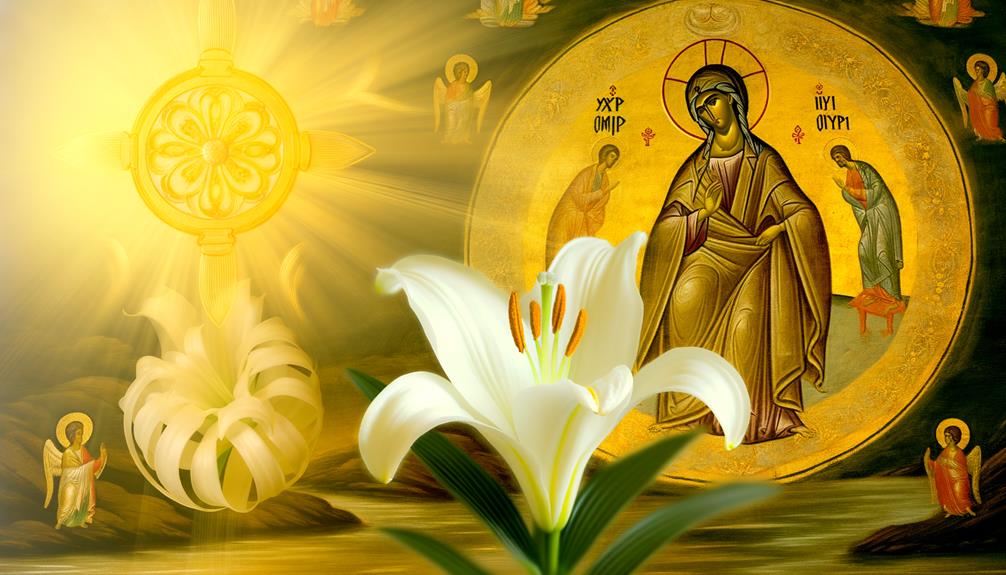Lilies in the Bible Meaning: Beauty and Purity
In the Bible, lilies symbolize purity, divine beauty, and God’s provision. References in Scripture, such as in the Song of Solomon (2:1) and Jesus’ Sermon on the Mount (Matthew 6:28-29), highlight these themes.
Historically, lilies were esteemed in ancient Israel for their delicate beauty and pure petals. This imagery contrasts human anxiety with trust in divine care, urging believers to rely on God.
Lilies also signify life’s fleeting nature and the importance of spiritual endeavors. As a potent metaphor for God’s splendor, they encapsulate the balance between ephemeral existence and eternal divine care, offering deeper insights.

Lilies in the Bible: Symbol of Purity, Beauty, and Divine Provision
| Term | Lilies |
|---|---|
| Biblical References | Song of Solomon 2:1–2; Matthew 6:28–29 |
| Symbolism | Purity, innocence, beauty, and divine provision |
| Jesus’ Teaching | Used lilies to illustrate God’s care and provision in Matthew 6 |
| Spiritual Insight | Encourages trust in God’s care and living a life of spiritual beauty |
| Poetic Usage | Describes the beloved in Song of Solomon, symbolizing love and grace |
| Application | Reminds believers of God’s attention to detail and the value of inner purity |
Biblical Symbolism of Lilies

In biblical literature, lilies are often used as powerful symbols of purity, divine beauty, and God’s provision, as evidenced by their mention in passages such as Song of Solomon 2:1 and Matthew 6:28-29.
Historically, lilies were esteemed in ancient Israel for their delicate beauty and pure white petals, signifying holiness and moral integrity.
Theologically, they represent God’s splendor and care for creation. In Matthew 6:28-29, Jesus uses lilies to teach dependence on divine providence, emphasizing that not even Solomon in his grandeur was arrayed like one of these.
Such scriptural references underscore the lily’s role as a metaphor for divine attributes, illustrating the intersection of natural beauty with spiritual truths.
Lilies in the Song of Solomon

Frequently celebrated for its poetic and allegorical richness, the Song of Solomon employs the imagery of lilies to encapsulate themes of love and purity, as seen in passages like Song of Solomon 2:1 and 2:16.
In 2:1, the beloved declares, ‘I am the rose of Sharon, and the lily of the valleys,’ symbolizing her beauty and innocence.
Similarly, in 2:16, ‘My beloved is mine, and I am his; he browses among the lilies,’ the lily metaphor illustrates mutual devotion and unblemished affection.
Historically, lilies were emblematic of purity and divine beauty in Ancient Near Eastern culture, enhancing the scriptural emphasis on sacred love and fidelity.
This consistent use underscores the profound theological symbolism inherent in the text.
Jesus and the Lilies

The teachings of Jesus often employed the imagery of lilies to convey profound spiritual truths, as exemplified in the Sermon on the Mount where He says, ‘Consider the lilies of the field, how they grow; they toil not, neither do they spin’ (Matthew 6:28).
This passage emphasizes reliance on divine provision, contrasting human anxiety with the effortless beauty of lilies, which thrive under God’s care. The historical context suggests a call to trust in God’s providence, urging listeners to seek His kingdom first (Matthew 6:33).
Theologically, lilies symbolize God’s bountiful grace and care for creation, reinforcing faith over worldly concerns.
| Aspect | Interpretation | Scriptural Reference |
|---|---|---|
| Divine Provision | God cares for His creation | Matthew 6:28 |
| Faith | Trust in divine care | Matthew 6:30 |
| Simplicity | Beauty without effort | Matthew 6:29 |
Purity and Innocence

Beyond the themes of divine provision and faith, lilies also hold significant representation of purity and innocence within biblical literature.
In the Song of Solomon 2:2, the lily is described as ‘a lily among thorns,’ signifying purity and virtue amidst corruption. This symbolism is further reinforced in Hosea 14:5, where Israel’s renewal is depicted as blossoming ‘like a lily,’ highlighting a return to innocence and divine favor.
Historically, lilies were often associated with the Virgin Mary in Christian art, emblematic of her immaculate purity.
These scriptural and historical contexts underscore the lily’s enduring role as a powerful symbol of unblemished beauty and moral integrity, reflecting the biblical ideal of living in a state of grace and innocence.
Lilies as Divine Favor

In the biblical context, lilies often represent divine favor, as seen in Matthew 6:28-30, where Jesus uses the lilies of the field to illustrate God’s providential care and promises.
This symbolism of purity and spiritual beauty underscores the lilies’ association with God’s blessings and the assurance of His provision.
Historically, the lily’s recurring appearance in religious texts reflects its esteemed status as a sign of God’s unwavering love and grace toward His creation.
Symbol of Purity
Lilies often symbolize purity in biblical texts, serving as a representation of divine favor and the unblemished nature of God’s love. This symbolism is deeply rooted in both the Old and New Scriptures, reflecting theological themes and scriptural teachings.
- Song of Solomon 2:1: The lily is mentioned as ‘the lily of the valleys,’ symbolizing beauty and purity in romantic love, which can be interpreted as God’s pure love for His people.
- Hosea 14:5: Here, God promises to be like the dew to Israel, making them blossom like a lily, symbolizing renewal and divine favor.
This rich symbolism underscores the theological significance of lilies as emblems of purity.
God’s Promises
Examining the scriptural references to lilies reveals their profound association with God’s promises and divine favor throughout biblical history.
In Song of Solomon 2:1, the lily is emblematic of God’s care and protection, symbolizing His steadfast love for His people.
Moreover, in Matthew 6:28-30, Jesus implores His followers to reflect on the lilies’ effortless beauty as a witness to God’s providence, suggesting that if God so adorns the lilies, He will surely provide for His children.
This imagery reinforces the notion that lilies epitomize divine favor, serving as a visible reminder of God’s unwavering commitment to nurture and sustain His creation.
Consequently, lilies underscore the enduring promises of God’s benevolence and faithfulness.
Spiritual Beauty
Reflecting on the emblematic significance of lilies in God’s promises, one finds that their spiritual beauty profoundly symbolizes divine favor and the inherent worth bestowed upon humanity.
Scriptural references, such as Matthew 6:28-29, underscore lilies as a sign of God’s provision and care. Historically, lilies have been associated with purity and resurrection, resonating with the themes of renewal and divine grace.
This symbolism is further enriched by theological interpretations that highlight:
- God’s meticulous care: Just as He adorns the lilies, He attends to human needs with precision (Luke 12:27).
- Inherent worth: The beauty and worth of lilies reflect human value in the eyes of God (Song of Solomon 2:1-2).
Symbol of Beauty

In the context of biblical literature, lilies are frequently depicted as a symbol of beauty, reflecting the divine craftsmanship of God’s creation.
The Song of Solomon poignantly illustrates this, describing the beloved as ‘a lily among thorns’ (Song of Solomon 2:2), thereby emphasizing purity and unparalleled beauty.
Additionally, Jesus’ reference to the lilies of the field in Matthew 6:28-29 underscores their effortless splendor, surpassing even Solomon’s regal attire.
Historically, lilies have been valued for their visual appeal and their fragrant significance in ancient Near Eastern cultures.
Lilies and Mortality

In biblical literature, lilies often symbolize human frailty and the fleeting nature of life.
As referenced in Matthew 6:28-30, Jesus uses lilies to exemplify the transient beauty of creation, emphasizing that even such splendor is ephemeral compared to divine eternal providence.
This metaphor underscores the theological perspective that human life is both precious and transient, urging a focus on spiritual rather than material pursuits.
Symbol of Human Frailty
Lilies, often depicted in biblical texts, poignantly symbolize the ephemeral nature of human life and mortality. This symbolism is intricately woven through various scriptural references, encapsulating the fragility and transient beauty of human existence.
- Biblical Allusions: In Psalm 103:15-16, lilies illustrate human life, ‘As for man, his days are like grass; he flourishes like a flower of the field; the wind passes over it, and it is gone.’
- Historical Context: In ancient Israel, lilies were common flora, making their symbolic use accessible and relatable to contemporary audiences.
This multilayered symbolism enriches theological understanding and personal introspection.
Life’s Transient Nature
The transient nature of life is poignantly encapsulated in the biblical imagery of lilies, emphasizing the fleeting beauty and impermanence of human existence.
In the Sermon on the Mount, Jesus highlights lilies’ ephemeral splendor: ‘Consider the lilies of the field, how they grow: they neither toil nor spin; yet I tell you, even Solomon in all his glory was not arrayed like one of these’ (Matthew 6:28-29, ESV).
This comparison underscores life’s brevity, drawing a parallel between the delicate, short-lived bloom of lilies and human mortality.
Historically, lilies have symbolized purity and renewal, yet their swift demise serves as a potent reminder of our temporal journey on earth, urging believers to seek eternal values beyond material concerns.
Resurrection and Renewal

As a profound symbol within Christian theology, lilies are often associated with the themes of resurrection and renewal, reflecting their frequent appearance in biblical texts during pivotal moments of transformation and rebirth.
Their significance is deeply rooted in scriptural references and historical context, shedding light on the divine message of hope and new beginnings.
Lilies are mentioned in several key biblical passages, underscoring their role in spiritual revival:
- Song of Solomon 2:1: ‘I am the rose of Sharon, and the lily of the valleys,’ symbolizing purity and renewal.
- Matthew 6:28: Jesus references lilies, emphasizing God’s provision and the beauty of creation.
Lilies in Christian Art

In Christian art, lilies serve as a visual representation of purity, divine beauty, and the hope of resurrection, often depicted in scenes of the Annunciation and the Resurrection.
The lily’s association with the Virgin Mary underscores her purity and divine grace, as exemplified in Luke 1:28, where she is greeted as “highly favored.”
In Resurrection art, lilies symbolize Christ’s victory over death, reflecting His proclamation in John 11:25, “I am the resurrection and the life.”
Historically, artists like Fra Angelico and Caravaggio have used lilies to convey these theological truths.
The white lily, in particular, is a symbol of the immaculate conception, an enduring emblem in religious iconography that emphasizes holiness and eternal life.
Modern Interpretations

While historical depictions of lilies in Christian art have profoundly shaped their symbolic meanings, contemporary interpretations continue to explore and expand upon these traditional associations.
Modern theologians and biblical scholars often investigate the layered symbolism of lilies in scripture, reflecting their broader spiritual relevance. Their meaning is frequently reassessed in light of current societal contexts and personal spiritual journeys.
- Renewal and Hope: Lilies are seen as symbols of rebirth and eternal life, as referenced in Hosea 14:5.
- Purity and Holiness: Echoing their historical symbolism, lilies continue to represent purity, as exemplified in Song of Solomon 2:1-2.
- Divine Provision: Reflecting Jesus’ teaching in Matthew 6:28-30, lilies underscore God’s care for creation, reinforcing faith and trust.
Conclusion
Lilies, deeply rooted in biblical text, symbolize purity, divine favor, and resurrection.
From the poetic verses of the Song of Solomon to Jesus’ teachings, lilies embody spiritual renewal and mortal transience.
Their recurring presence in Christian art underscores their theological significance, bridging historical context and scriptural reverence.
Modern interpretations continue to honor these themes, illustrating the enduring power of lilies as symbols of divine grace and eternal life.
Consequently, the lily remains a timeless emblem of sacred beauty and spiritual truth.






